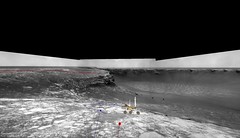QUOTE (CosmicRocker @ Sep 25 2007, 09:34 PM)

... I think one would be hard-pressed to explain Overgaard's train of nested troughs simply as subhorizontal contacts V-ing upstream. I'll attach an anaglyph of Overgaard for others who may want to look at it in 3D.
...The thing that really freaks me out when looking at these rocks is the realization that I have never seen such mildly altered sedimentary rocks that are so old, let alone from another planet. We all really do need to keep an eye on our blinders.
Tom - Thanks for the nice anaglyph of Overgaard. When I look at it, I clearly see the topographic irregularities (notches) I referred to in the lower part of the rock - yielding the "smile-shaped features" referred to in the original NASA caption, but only because Pancam views things from 5 feet up (i.e., they are a topographic artifact of the angle of view). Perhaps we agree there. The "nested troughs" area in the upper right part of the rock is a lot trickier because (1) it contains an actual cross-bed (a normal one) rather than simple horizontal planar beds and (2) the edges of some beds are broken off, making bed continuity difficult to follow across notches. Still, the large notch at the far upper right, and the bedding contouring into and around it, is clearly visible, and the other beds likewise can be followed with considerable mental effort. So we continue to agree to disagree.
Regarding your closing comment, "mildly altered" is probably the key phase, especially considering how salty and old these rocks are. To me that very freshness indicates that they have never seen liquid water for any extended period of time, if at all, in contrast to the extant hypothesis of multiple episodes of acid groundwater immersion and even surficial water flow. To my predjudiced eye they look remarkably like some fresh volcanic surge deposits do on Earth, including the very "toothy" or "ashy-looking" edges of the exposed beds (as seen in the excellent panorama of James Canvin's post #127). They sure don't look like any variety of terrestrial sandstone or evaporite I've ever seen (and I think we can agree on that).
Here for your amusement are some actual current ripples in fluvial sand from the Grand Canyon (2003 rafting trip).
Click to view attachmentProbably not directly comparable, because they seem to have formed in an eddy next to the cliff, but certainly not artifacts of the viewing angle (which was from the side, because unlike the Pancam, I can bend down

). BTW, I took that photo in May, 2003, before I had ever even heard of "festoons". I rafted down the Canyon again last July (Knauth organizes trips every year), and looked for similar flow features along the shoreline, but river levels were just too high (twice the normal discharge owing to lots of flash flooding below the dam at Lake Powell). Made for exciting rapids though!
-- HDP Don



